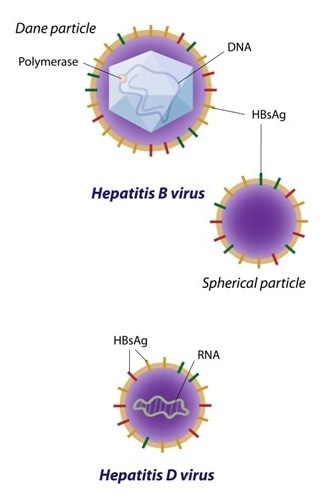Hepatitis B is a life-threatening liver infection that is caused by the hepatitis B virus, whereas, hepatitis D infection only occurs in people who are infected with the hepatitis B virus. It replicates autonomously within hepatocytes, but requires hepatitis B surface antigen for proliferation.

Hepatitis D and Hepatitis B
Common Symptoms
Majority of carriers of hepatitis B virus remain asymptomatic during the initial phase of acute infection, albeit some suffer from acute symptoms which prevail for few weeks.
Like hepatitis B virus, most of the people with hepatitis D virus infection also do not show any symptoms for long. Others may show an exacerbation of their pre-existing hepatitis B symptoms.
Common symptoms include weakness, fatigue, nausea, fever, joint pain, abdominal pain, yellowing of eyes or skin (jaundice), vomiting, dark urine etc.
Transmission
The incubation period of hepatitis D is approximately 14 to 60 days, while for hepatitis B it is approximately 75 days, but may also vary from 30 to 180 days.
Both hepatitis D and hepatitis B viruses can spread via blood transfusion, saliva, needlestick injury, intravenous drug supplies, or semen and vaginal secretions.Sexual transmission can occur in unvaccinated homosexual men, heterosexual persons with multiple sex partners, or through sex workers.
Hepatitis D virus can also be transmitted from mother to child, though very rarely. However, pregnant women with hepatitis B can transmit the virus to their babies at the time of birth.
Coexistence of Hepatitis B and Hepatitis D
Hepatitis B and Hepatitis D infections can occur together as a coinfection or a superinfection.
Coinfection: A coinfection takes placedue to simultaneous infection with both hepatitis D and hepatitis B viruses. This results in acute hepatitis D or hepatitis B. Coinfections can give rise to fulminant hepatitis.
Usually, patients are able to recuperate from the acute hepatitis D and hepatitis B infections, and the viruses head off. However, approximately 5% of the coinfected patients suffer from chronic infections which do not recover easily.
Superinfection: A superinfection takes place in the patients who are already infected with hepatitis B infection and further get infected with hepatitis D. The symptoms of a superinfection are usually acute and severe in nature.
A huge majority of the patients having a superinfection are incapable of combating hepatitis D virus infection, and consequently suffer from chronic hepatitis D. Hence, such patients can contract chronic hepatitis D and hepatitis B simultaneously.
Complications
Chronic hepatitis B and hepatitis D infections can result in serious complications, such as cirrhosis (scarring of the liver), liver cancer, liver failure, and other conditions like development of kidney disease or inflammation of blood vessels.
Management
Prevention of hepatitis D virus infection depends on the prevention of hepatitis B. In order to reduce the chances of infection, the hepatitis B vaccine should be administered prophylactically.
Besides vaccination having a safe sex, covering the open cuts, sores, or abrasions with waterproof dressings, and refraining from sharing intravenous needles or drug supplies protects the body against both HepatitisB and D infections.
There is no specific treatment for acute hepatitis B.
The most important focus of management should be at maintaining optimum nutrition and a healthy state. This also includes supplementing the fluid balance of the body by drinking sufficient quantities of water. Oral antiviral agentsare also employed for treating chronic hepatitis B infection.
At present, there is no vaccine available for hepatitis D infection. Hepatitis B vaccine can keep hepatitis D in check by preventing hepatitis B infection.
Currently, pegylated interferon is the sole approved class of medication that has proven beneficial in treating hepatitis D.
No comments:
Post a Comment
Note: Only a member of this blog may post a comment.